Contract Law Assignment: Analysis of Two Scenarios
VerifiedAdded on 2023/06/04
|7
|1918
|87
Homework Assignment
AI Summary
This contract law assignment delves into two scenarios, exploring key principles of contract formation. The first scenario examines the concept of acceptance, specifically whether silence can constitute acceptance, and analyzes the elements of an offer and acceptance. The second scenario focuses on the intention to create legal relations, particularly in domestic agreements, and assesses when such arrangements are considered legally binding. The assignment applies legal rules to the given facts, providing a detailed analysis of each scenario and concluding whether a valid contract was formed in each case. The analysis considers aspects such as clear communication of the offer, conditional acceptance (counter-offer), and the presumption regarding the intention to be legally bound in domestic agreements. The assignment aims to provide a comprehensive understanding of contract law principles through practical application.
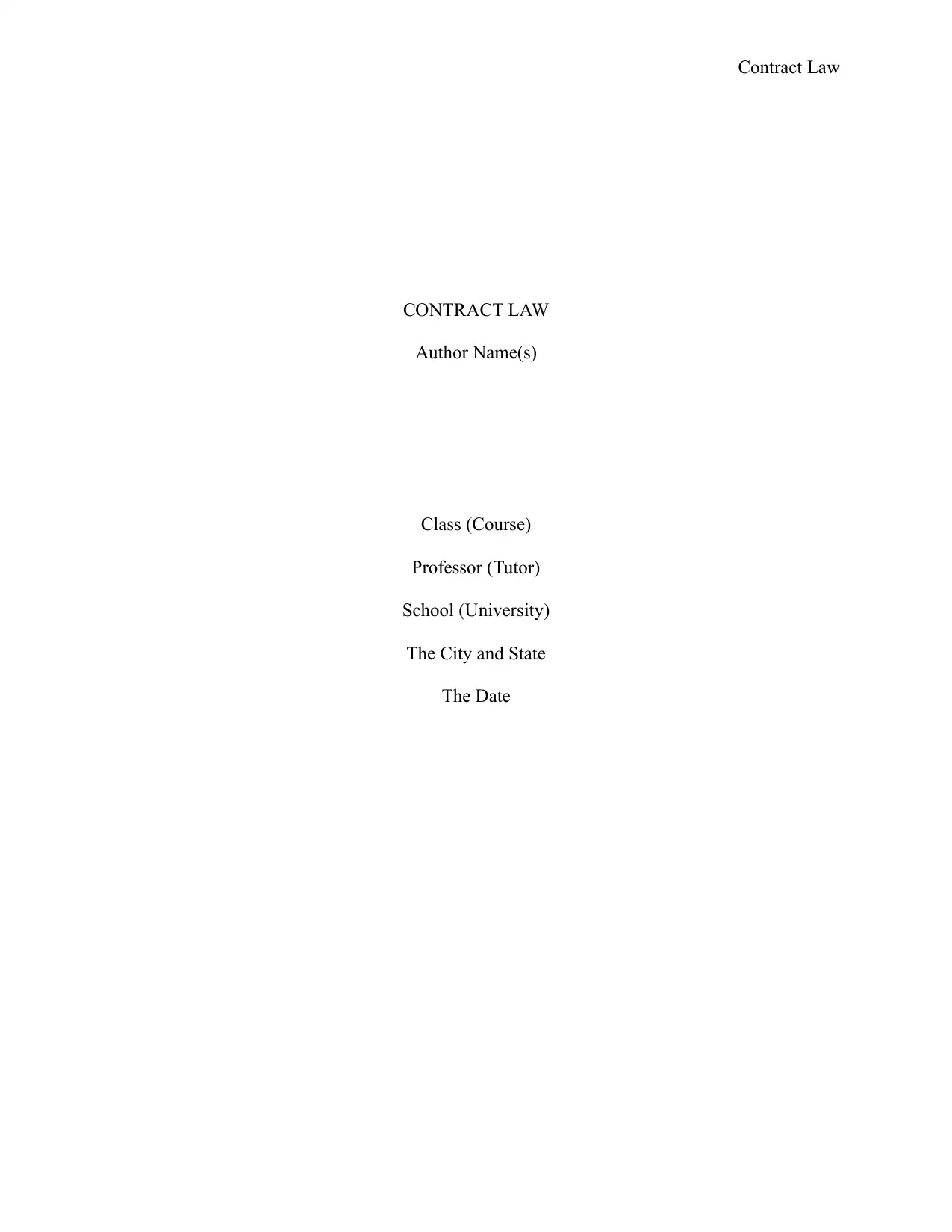
Contract Law
CONTRACT LAW
Author Name(s)
Class (Course)
Professor (Tutor)
School (University)
The City and State
The Date
CONTRACT LAW
Author Name(s)
Class (Course)
Professor (Tutor)
School (University)
The City and State
The Date
Paraphrase This Document
Need a fresh take? Get an instant paraphrase of this document with our AI Paraphraser
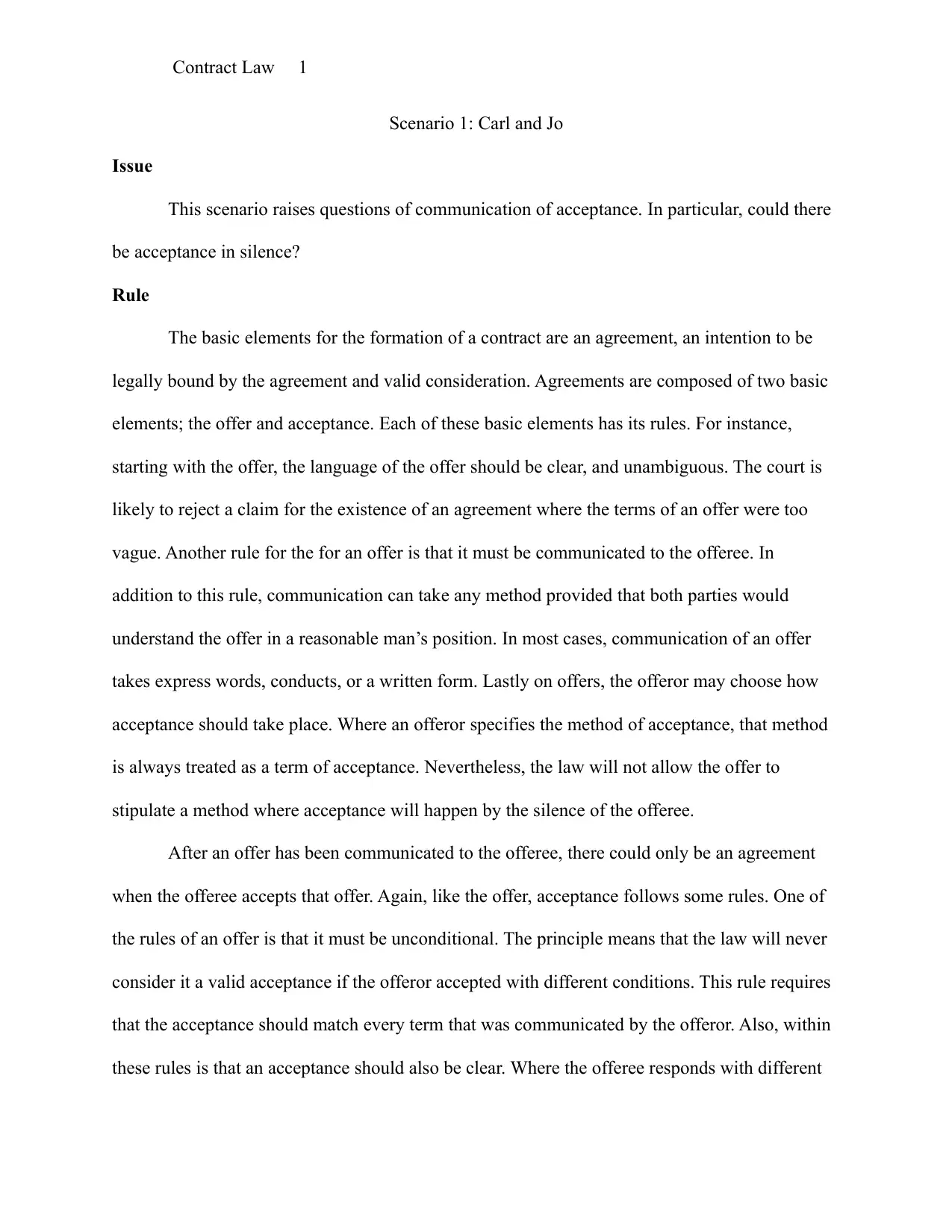
Contract Law 1
Scenario 1: Carl and Jo
Issue
This scenario raises questions of communication of acceptance. In particular, could there
be acceptance in silence?
Rule
The basic elements for the formation of a contract are an agreement, an intention to be
legally bound by the agreement and valid consideration. Agreements are composed of two basic
elements; the offer and acceptance. Each of these basic elements has its rules. For instance,
starting with the offer, the language of the offer should be clear, and unambiguous. The court is
likely to reject a claim for the existence of an agreement where the terms of an offer were too
vague. Another rule for the for an offer is that it must be communicated to the offeree. In
addition to this rule, communication can take any method provided that both parties would
understand the offer in a reasonable man’s position. In most cases, communication of an offer
takes express words, conducts, or a written form. Lastly on offers, the offeror may choose how
acceptance should take place. Where an offeror specifies the method of acceptance, that method
is always treated as a term of acceptance. Nevertheless, the law will not allow the offer to
stipulate a method where acceptance will happen by the silence of the offeree.
After an offer has been communicated to the offeree, there could only be an agreement
when the offeree accepts that offer. Again, like the offer, acceptance follows some rules. One of
the rules of an offer is that it must be unconditional. The principle means that the law will never
consider it a valid acceptance if the offeror accepted with different conditions. This rule requires
that the acceptance should match every term that was communicated by the offeror. Also, within
these rules is that an acceptance should also be clear. Where the offeree responds with different
Scenario 1: Carl and Jo
Issue
This scenario raises questions of communication of acceptance. In particular, could there
be acceptance in silence?
Rule
The basic elements for the formation of a contract are an agreement, an intention to be
legally bound by the agreement and valid consideration. Agreements are composed of two basic
elements; the offer and acceptance. Each of these basic elements has its rules. For instance,
starting with the offer, the language of the offer should be clear, and unambiguous. The court is
likely to reject a claim for the existence of an agreement where the terms of an offer were too
vague. Another rule for the for an offer is that it must be communicated to the offeree. In
addition to this rule, communication can take any method provided that both parties would
understand the offer in a reasonable man’s position. In most cases, communication of an offer
takes express words, conducts, or a written form. Lastly on offers, the offeror may choose how
acceptance should take place. Where an offeror specifies the method of acceptance, that method
is always treated as a term of acceptance. Nevertheless, the law will not allow the offer to
stipulate a method where acceptance will happen by the silence of the offeree.
After an offer has been communicated to the offeree, there could only be an agreement
when the offeree accepts that offer. Again, like the offer, acceptance follows some rules. One of
the rules of an offer is that it must be unconditional. The principle means that the law will never
consider it a valid acceptance if the offeror accepted with different conditions. This rule requires
that the acceptance should match every term that was communicated by the offeror. Also, within
these rules is that an acceptance should also be clear. Where the offeree responds with different
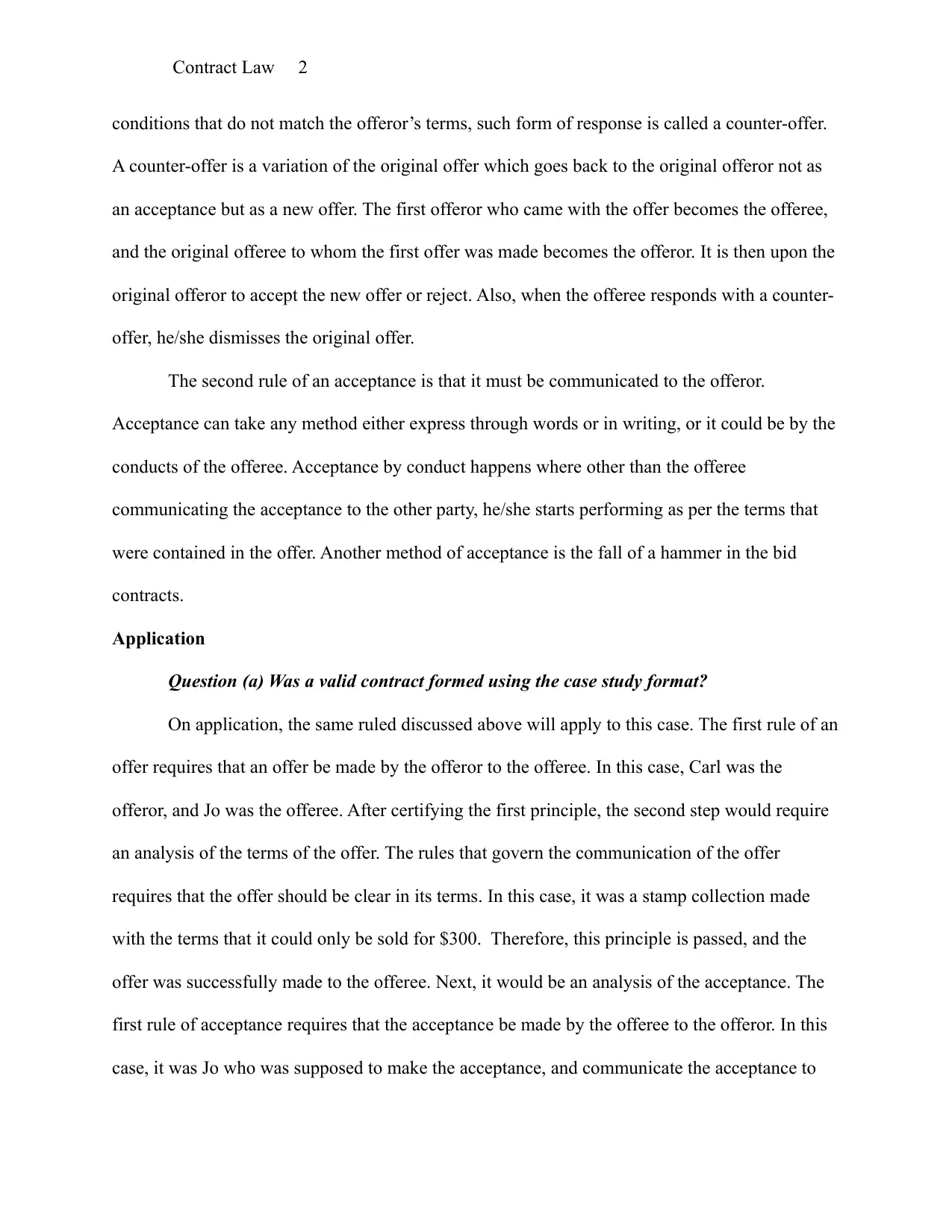
Contract Law 2
conditions that do not match the offeror’s terms, such form of response is called a counter-offer.
A counter-offer is a variation of the original offer which goes back to the original offeror not as
an acceptance but as a new offer. The first offeror who came with the offer becomes the offeree,
and the original offeree to whom the first offer was made becomes the offeror. It is then upon the
original offeror to accept the new offer or reject. Also, when the offeree responds with a counter-
offer, he/she dismisses the original offer.
The second rule of an acceptance is that it must be communicated to the offeror.
Acceptance can take any method either express through words or in writing, or it could be by the
conducts of the offeree. Acceptance by conduct happens where other than the offeree
communicating the acceptance to the other party, he/she starts performing as per the terms that
were contained in the offer. Another method of acceptance is the fall of a hammer in the bid
contracts.
Application
Question (a) Was a valid contract formed using the case study format?
On application, the same ruled discussed above will apply to this case. The first rule of an
offer requires that an offer be made by the offeror to the offeree. In this case, Carl was the
offeror, and Jo was the offeree. After certifying the first principle, the second step would require
an analysis of the terms of the offer. The rules that govern the communication of the offer
requires that the offer should be clear in its terms. In this case, it was a stamp collection made
with the terms that it could only be sold for $300. Therefore, this principle is passed, and the
offer was successfully made to the offeree. Next, it would be an analysis of the acceptance. The
first rule of acceptance requires that the acceptance be made by the offeree to the offeror. In this
case, it was Jo who was supposed to make the acceptance, and communicate the acceptance to
conditions that do not match the offeror’s terms, such form of response is called a counter-offer.
A counter-offer is a variation of the original offer which goes back to the original offeror not as
an acceptance but as a new offer. The first offeror who came with the offer becomes the offeree,
and the original offeree to whom the first offer was made becomes the offeror. It is then upon the
original offeror to accept the new offer or reject. Also, when the offeree responds with a counter-
offer, he/she dismisses the original offer.
The second rule of an acceptance is that it must be communicated to the offeror.
Acceptance can take any method either express through words or in writing, or it could be by the
conducts of the offeree. Acceptance by conduct happens where other than the offeree
communicating the acceptance to the other party, he/she starts performing as per the terms that
were contained in the offer. Another method of acceptance is the fall of a hammer in the bid
contracts.
Application
Question (a) Was a valid contract formed using the case study format?
On application, the same ruled discussed above will apply to this case. The first rule of an
offer requires that an offer be made by the offeror to the offeree. In this case, Carl was the
offeror, and Jo was the offeree. After certifying the first principle, the second step would require
an analysis of the terms of the offer. The rules that govern the communication of the offer
requires that the offer should be clear in its terms. In this case, it was a stamp collection made
with the terms that it could only be sold for $300. Therefore, this principle is passed, and the
offer was successfully made to the offeree. Next, it would be an analysis of the acceptance. The
first rule of acceptance requires that the acceptance be made by the offeree to the offeror. In this
case, it was Jo who was supposed to make the acceptance, and communicate the acceptance to
⊘ This is a preview!⊘
Do you want full access?
Subscribe today to unlock all pages.

Trusted by 1+ million students worldwide
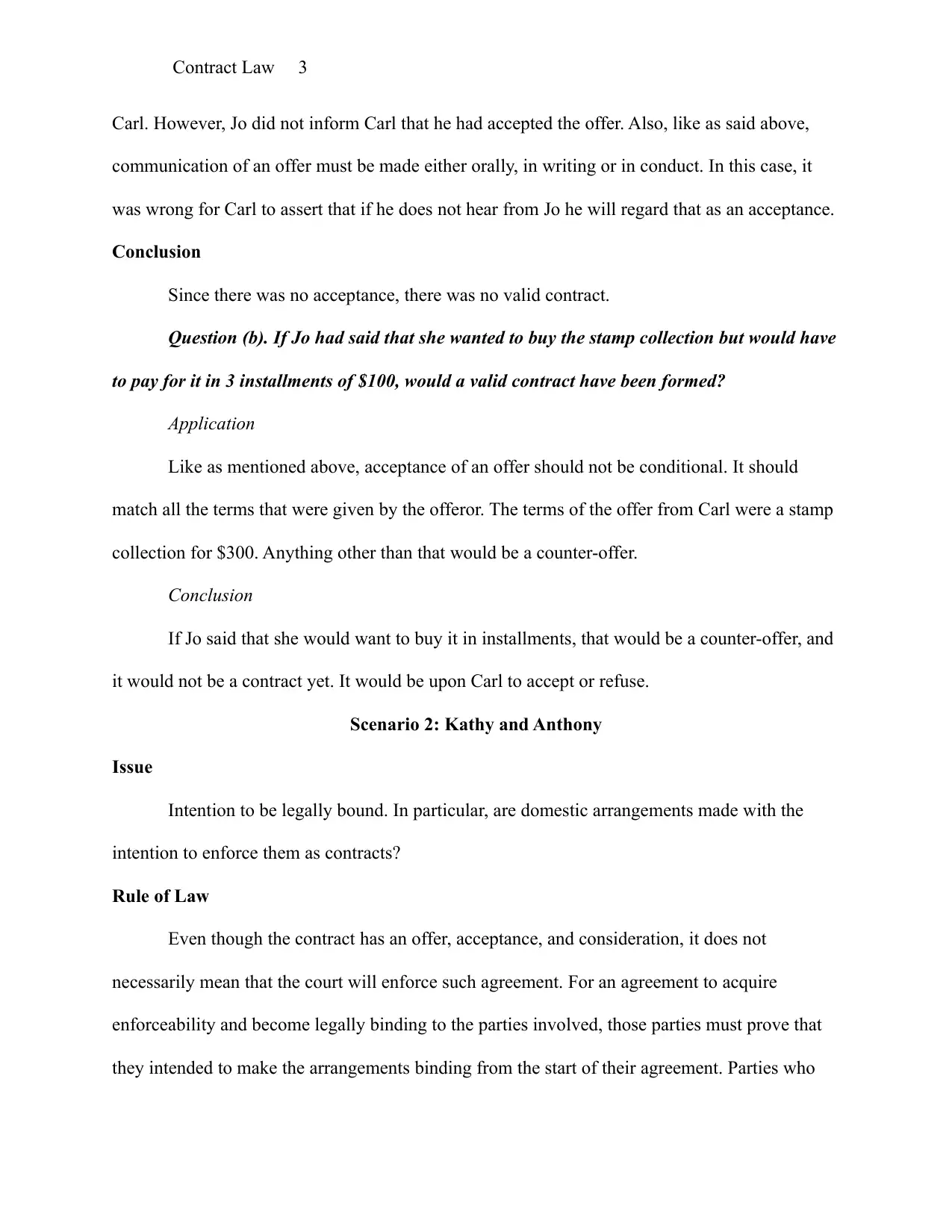
Contract Law 3
Carl. However, Jo did not inform Carl that he had accepted the offer. Also, like as said above,
communication of an offer must be made either orally, in writing or in conduct. In this case, it
was wrong for Carl to assert that if he does not hear from Jo he will regard that as an acceptance.
Conclusion
Since there was no acceptance, there was no valid contract.
Question (b). If Jo had said that she wanted to buy the stamp collection but would have
to pay for it in 3 installments of $100, would a valid contract have been formed?
Application
Like as mentioned above, acceptance of an offer should not be conditional. It should
match all the terms that were given by the offeror. The terms of the offer from Carl were a stamp
collection for $300. Anything other than that would be a counter-offer.
Conclusion
If Jo said that she would want to buy it in installments, that would be a counter-offer, and
it would not be a contract yet. It would be upon Carl to accept or refuse.
Scenario 2: Kathy and Anthony
Issue
Intention to be legally bound. In particular, are domestic arrangements made with the
intention to enforce them as contracts?
Rule of Law
Even though the contract has an offer, acceptance, and consideration, it does not
necessarily mean that the court will enforce such agreement. For an agreement to acquire
enforceability and become legally binding to the parties involved, those parties must prove that
they intended to make the arrangements binding from the start of their agreement. Parties who
Carl. However, Jo did not inform Carl that he had accepted the offer. Also, like as said above,
communication of an offer must be made either orally, in writing or in conduct. In this case, it
was wrong for Carl to assert that if he does not hear from Jo he will regard that as an acceptance.
Conclusion
Since there was no acceptance, there was no valid contract.
Question (b). If Jo had said that she wanted to buy the stamp collection but would have
to pay for it in 3 installments of $100, would a valid contract have been formed?
Application
Like as mentioned above, acceptance of an offer should not be conditional. It should
match all the terms that were given by the offeror. The terms of the offer from Carl were a stamp
collection for $300. Anything other than that would be a counter-offer.
Conclusion
If Jo said that she would want to buy it in installments, that would be a counter-offer, and
it would not be a contract yet. It would be upon Carl to accept or refuse.
Scenario 2: Kathy and Anthony
Issue
Intention to be legally bound. In particular, are domestic arrangements made with the
intention to enforce them as contracts?
Rule of Law
Even though the contract has an offer, acceptance, and consideration, it does not
necessarily mean that the court will enforce such agreement. For an agreement to acquire
enforceability and become legally binding to the parties involved, those parties must prove that
they intended to make the arrangements binding from the start of their agreement. Parties who
Paraphrase This Document
Need a fresh take? Get an instant paraphrase of this document with our AI Paraphraser
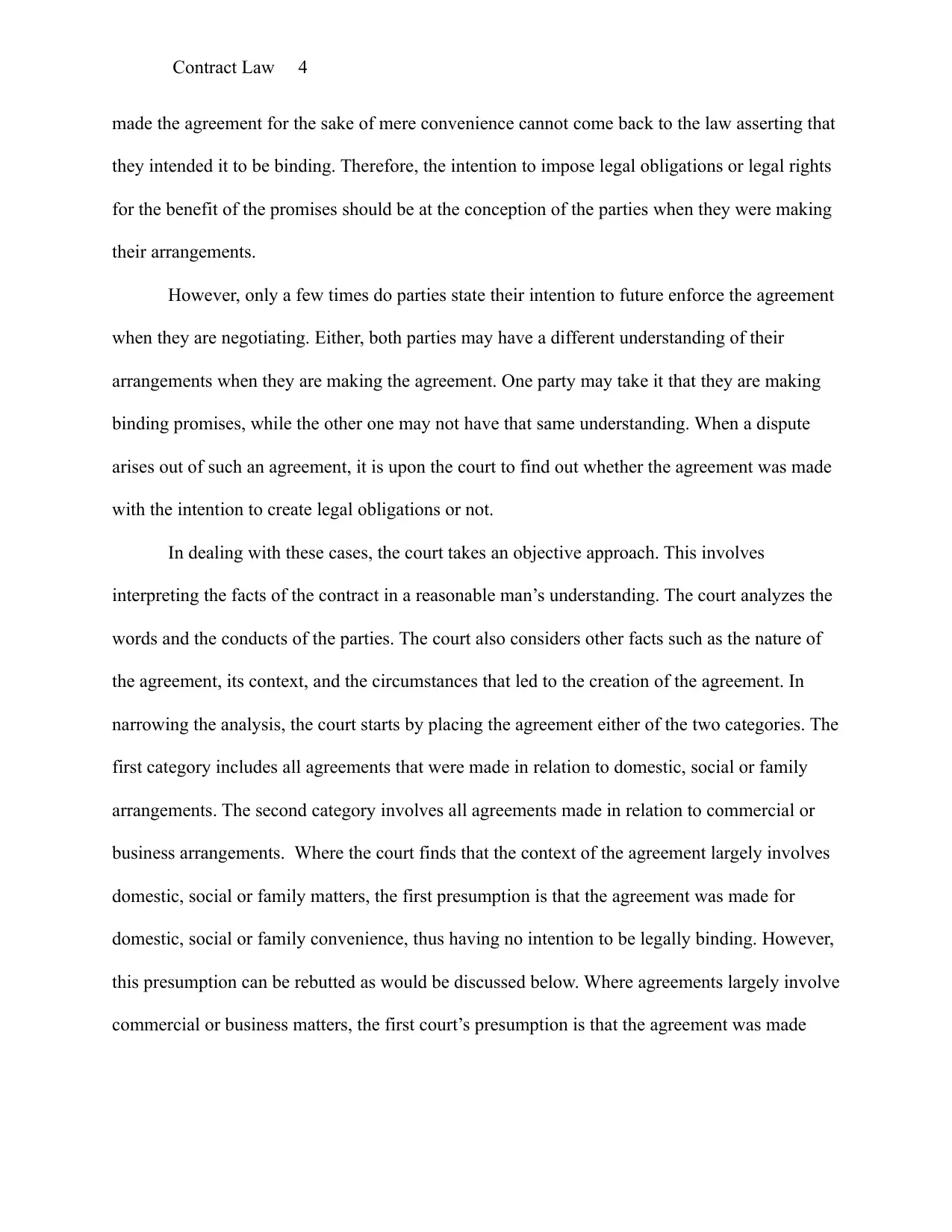
Contract Law 4
made the agreement for the sake of mere convenience cannot come back to the law asserting that
they intended it to be binding. Therefore, the intention to impose legal obligations or legal rights
for the benefit of the promises should be at the conception of the parties when they were making
their arrangements.
However, only a few times do parties state their intention to future enforce the agreement
when they are negotiating. Either, both parties may have a different understanding of their
arrangements when they are making the agreement. One party may take it that they are making
binding promises, while the other one may not have that same understanding. When a dispute
arises out of such an agreement, it is upon the court to find out whether the agreement was made
with the intention to create legal obligations or not.
In dealing with these cases, the court takes an objective approach. This involves
interpreting the facts of the contract in a reasonable man’s understanding. The court analyzes the
words and the conducts of the parties. The court also considers other facts such as the nature of
the agreement, its context, and the circumstances that led to the creation of the agreement. In
narrowing the analysis, the court starts by placing the agreement either of the two categories. The
first category includes all agreements that were made in relation to domestic, social or family
arrangements. The second category involves all agreements made in relation to commercial or
business arrangements. Where the court finds that the context of the agreement largely involves
domestic, social or family matters, the first presumption is that the agreement was made for
domestic, social or family convenience, thus having no intention to be legally binding. However,
this presumption can be rebutted as would be discussed below. Where agreements largely involve
commercial or business matters, the first court’s presumption is that the agreement was made
made the agreement for the sake of mere convenience cannot come back to the law asserting that
they intended it to be binding. Therefore, the intention to impose legal obligations or legal rights
for the benefit of the promises should be at the conception of the parties when they were making
their arrangements.
However, only a few times do parties state their intention to future enforce the agreement
when they are negotiating. Either, both parties may have a different understanding of their
arrangements when they are making the agreement. One party may take it that they are making
binding promises, while the other one may not have that same understanding. When a dispute
arises out of such an agreement, it is upon the court to find out whether the agreement was made
with the intention to create legal obligations or not.
In dealing with these cases, the court takes an objective approach. This involves
interpreting the facts of the contract in a reasonable man’s understanding. The court analyzes the
words and the conducts of the parties. The court also considers other facts such as the nature of
the agreement, its context, and the circumstances that led to the creation of the agreement. In
narrowing the analysis, the court starts by placing the agreement either of the two categories. The
first category includes all agreements that were made in relation to domestic, social or family
arrangements. The second category involves all agreements made in relation to commercial or
business arrangements. Where the court finds that the context of the agreement largely involves
domestic, social or family matters, the first presumption is that the agreement was made for
domestic, social or family convenience, thus having no intention to be legally binding. However,
this presumption can be rebutted as would be discussed below. Where agreements largely involve
commercial or business matters, the first court’s presumption is that the agreement was made
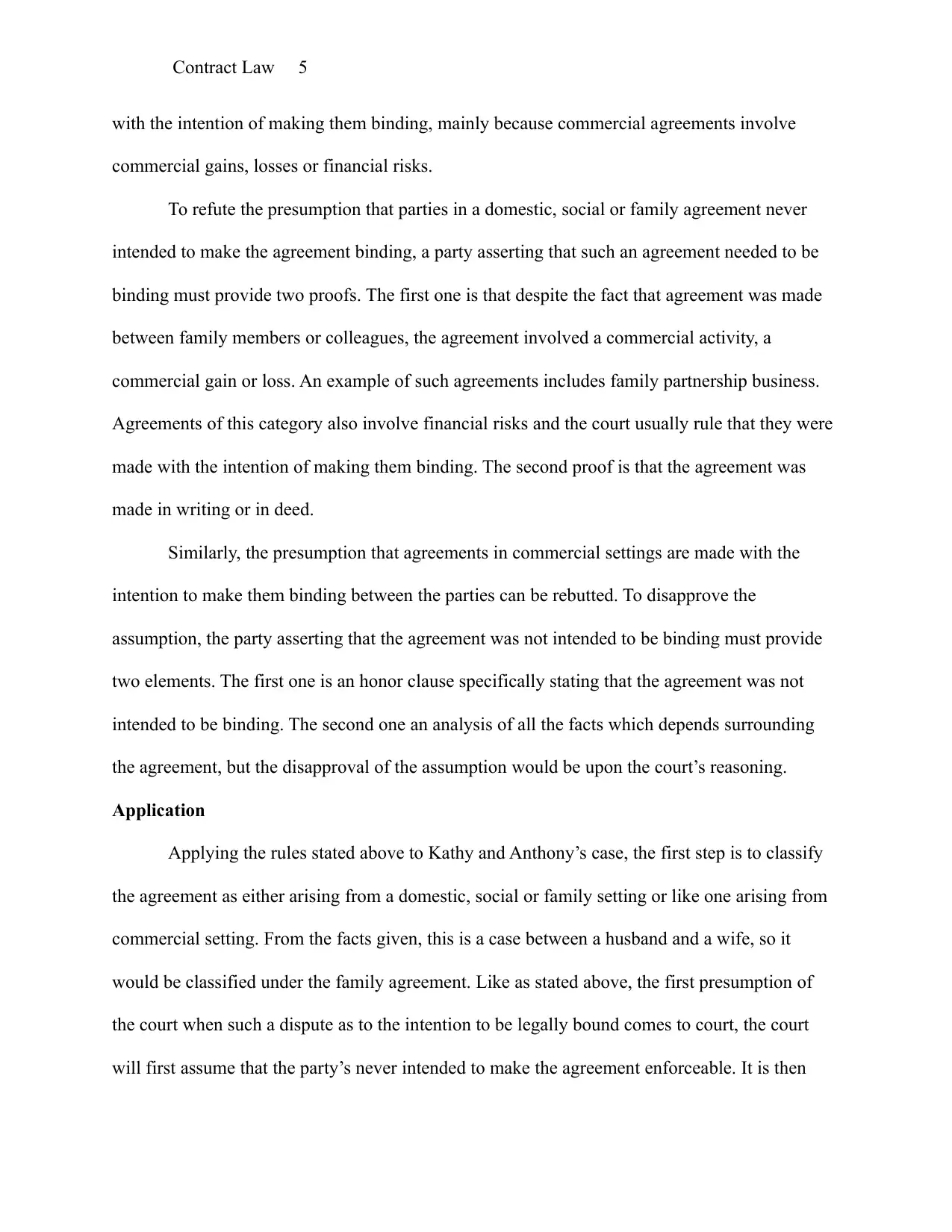
Contract Law 5
with the intention of making them binding, mainly because commercial agreements involve
commercial gains, losses or financial risks.
To refute the presumption that parties in a domestic, social or family agreement never
intended to make the agreement binding, a party asserting that such an agreement needed to be
binding must provide two proofs. The first one is that despite the fact that agreement was made
between family members or colleagues, the agreement involved a commercial activity, a
commercial gain or loss. An example of such agreements includes family partnership business.
Agreements of this category also involve financial risks and the court usually rule that they were
made with the intention of making them binding. The second proof is that the agreement was
made in writing or in deed.
Similarly, the presumption that agreements in commercial settings are made with the
intention to make them binding between the parties can be rebutted. To disapprove the
assumption, the party asserting that the agreement was not intended to be binding must provide
two elements. The first one is an honor clause specifically stating that the agreement was not
intended to be binding. The second one an analysis of all the facts which depends surrounding
the agreement, but the disapproval of the assumption would be upon the court’s reasoning.
Application
Applying the rules stated above to Kathy and Anthony’s case, the first step is to classify
the agreement as either arising from a domestic, social or family setting or like one arising from
commercial setting. From the facts given, this is a case between a husband and a wife, so it
would be classified under the family agreement. Like as stated above, the first presumption of
the court when such a dispute as to the intention to be legally bound comes to court, the court
will first assume that the party’s never intended to make the agreement enforceable. It is then
with the intention of making them binding, mainly because commercial agreements involve
commercial gains, losses or financial risks.
To refute the presumption that parties in a domestic, social or family agreement never
intended to make the agreement binding, a party asserting that such an agreement needed to be
binding must provide two proofs. The first one is that despite the fact that agreement was made
between family members or colleagues, the agreement involved a commercial activity, a
commercial gain or loss. An example of such agreements includes family partnership business.
Agreements of this category also involve financial risks and the court usually rule that they were
made with the intention of making them binding. The second proof is that the agreement was
made in writing or in deed.
Similarly, the presumption that agreements in commercial settings are made with the
intention to make them binding between the parties can be rebutted. To disapprove the
assumption, the party asserting that the agreement was not intended to be binding must provide
two elements. The first one is an honor clause specifically stating that the agreement was not
intended to be binding. The second one an analysis of all the facts which depends surrounding
the agreement, but the disapproval of the assumption would be upon the court’s reasoning.
Application
Applying the rules stated above to Kathy and Anthony’s case, the first step is to classify
the agreement as either arising from a domestic, social or family setting or like one arising from
commercial setting. From the facts given, this is a case between a husband and a wife, so it
would be classified under the family agreement. Like as stated above, the first presumption of
the court when such a dispute as to the intention to be legally bound comes to court, the court
will first assume that the party’s never intended to make the agreement enforceable. It is then
⊘ This is a preview!⊘
Do you want full access?
Subscribe today to unlock all pages.

Trusted by 1+ million students worldwide
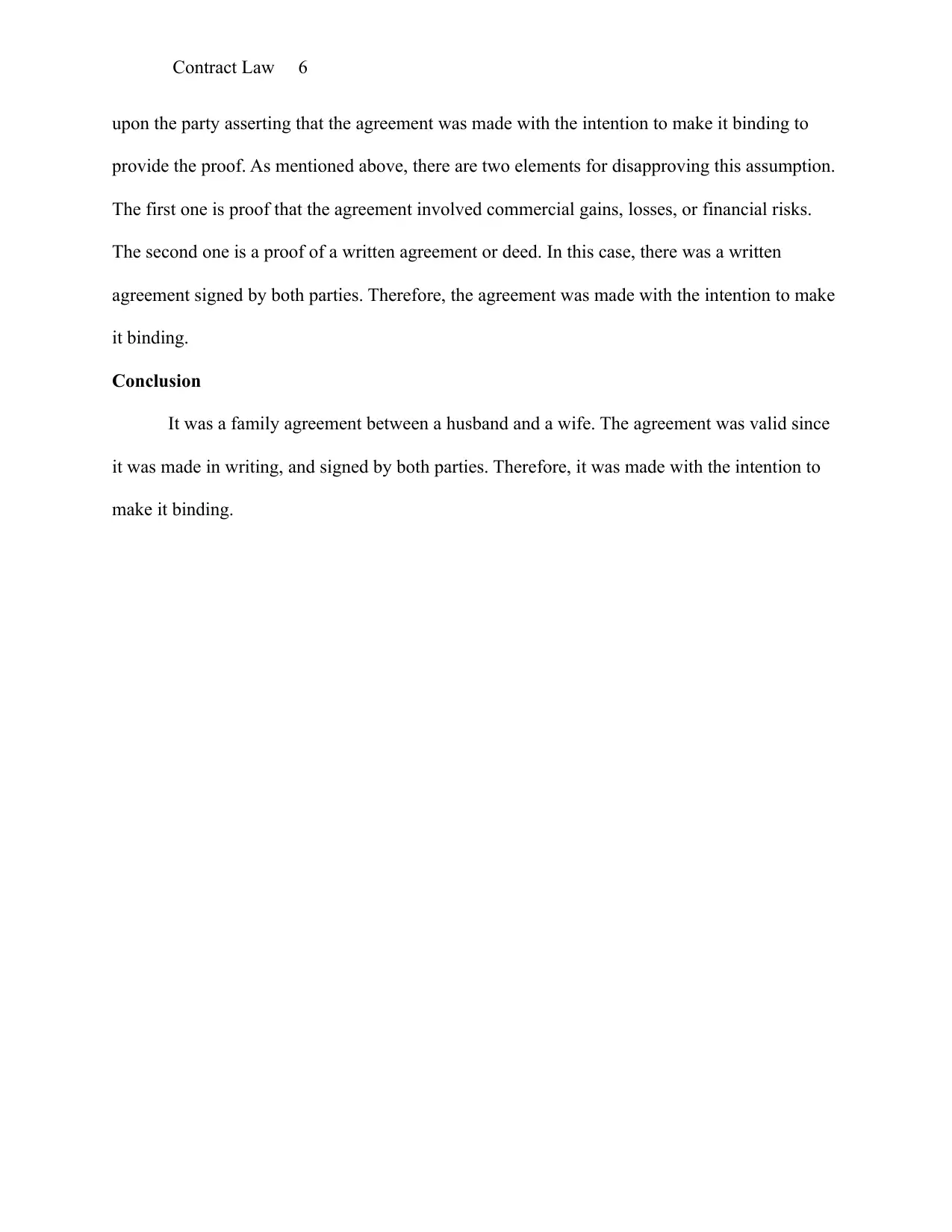
Contract Law 6
upon the party asserting that the agreement was made with the intention to make it binding to
provide the proof. As mentioned above, there are two elements for disapproving this assumption.
The first one is proof that the agreement involved commercial gains, losses, or financial risks.
The second one is a proof of a written agreement or deed. In this case, there was a written
agreement signed by both parties. Therefore, the agreement was made with the intention to make
it binding.
Conclusion
It was a family agreement between a husband and a wife. The agreement was valid since
it was made in writing, and signed by both parties. Therefore, it was made with the intention to
make it binding.
upon the party asserting that the agreement was made with the intention to make it binding to
provide the proof. As mentioned above, there are two elements for disapproving this assumption.
The first one is proof that the agreement involved commercial gains, losses, or financial risks.
The second one is a proof of a written agreement or deed. In this case, there was a written
agreement signed by both parties. Therefore, the agreement was made with the intention to make
it binding.
Conclusion
It was a family agreement between a husband and a wife. The agreement was valid since
it was made in writing, and signed by both parties. Therefore, it was made with the intention to
make it binding.
1 out of 7
Related Documents
Your All-in-One AI-Powered Toolkit for Academic Success.
+13062052269
info@desklib.com
Available 24*7 on WhatsApp / Email
![[object Object]](/_next/static/media/star-bottom.7253800d.svg)
Unlock your academic potential
Copyright © 2020–2025 A2Z Services. All Rights Reserved. Developed and managed by ZUCOL.





